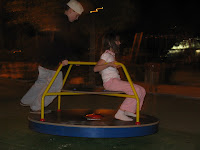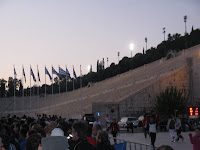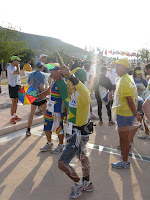Greece was great, we really liked it. The climate was very mild, even in November. The beaches were nice, the prices were the best we've found in Europe, and the history was amazing.
We arrived late Thursday, did our sightseeing on Friday, had a lazy day Saturday - that's when we realized that the museums close around 3:00 for the day - and then on Sunday, I ran the marathon and the family went to the museum.
So basically, we did one day of real sightseeing - and these are the pix.
We arrived late Thursday, did our sightseeing on Friday, had a lazy day Saturday - that's when we realized that the museums close around 3:00 for the day - and then on Sunday, I ran the marathon and the family went to the museum.
So basically, we did one day of real sightseeing - and these are the pix.
This is a modern government building. It just so happened that the bus dropped us nearby, so I had to take a picture. It is beautiful. We think we may have witnessed a terrorist attack on the building next door, but could not quite figure it out. The bad guys were running out of the building just as our bus drove past. Shirleen and the kids saw the bad guys, I didn't. I assumed it was a movie being filmed. But we all saw the riot police show up a little while later, so something definitely went on. It was confusing and since our Greek was zero, we couldn't ask.
This is the Temple of Zeus. These columns are about 50 feet tall each. Imagine the size of the thing back when it was whole! In one of the shots you can see a column on the ground and can see how they assembled them by stacking the sections. In the third picture (taken from the Acropolis) you can see the building's footprint and imagine the size.
Hadrian's Arch, honoring the Roman Emperor. In the right picture, looking through the arch, you can see the Acropolis rising in the background. The Acropolis is the whole hill, which dominates the city. On it are several structures.
This is the lower wall of the Acropolis, behind the wall is a theater made of marble. There was a second theater on the Acropolis, but it is currently in ruins. Basically just some stones laying around.
This is the entrance to the top of the Acropolis which I believe is called the temple of Athena Nike (goddess of running shoes). You get a good look at a column and can see how the pieces fit together - sample pieces in the right picture. It is undergoing a major restoration right now.
This is the Erechtheion, dedicated to Athena (the goddess of the city) and Poseidon, the god of the sea. The picture on the right is a close up of the female statues on 'The Virgin Porch.'
A view from the top, you can see a couple of the other hills in Athens in the left picture. The right picture is looking down on Hadrian's Arch, The Temple of Zeus and in the background you can see the Panathinaikon stadium (the stadium built for the first modern Olympics in 1896) where the marathon ended.
The biggest building on the Acropolis, the Parthenon. It was originally built as a temple to Athena, but has also been rededicated as a temple to the Virgin Mary, and later a Mosque.
Looking down from the Acropolis on the Ancient Agora, the ancient marketplace in Athens. In the left picture you see the only building of its kind in Greece that is still standing. One of the Roman Emperors decreed that all the Greek temples should be destroyed, so they are all in ruins. In the center is a reconstruction of the largest building in the Agora, the money was donated by John D Rockefeller. The right picture is a Greek Orthodox church beside the Agora.
These fuzzy shots are actually taken from our table at the restaurant where we ate dinner. (delicious!) A spectacular view of the Acropolis which as you can see, they light up at night.



As much as we loved Athens, John and Brittany's favorite thing was the playground across the street from the hotel.
In summary, we came to Athens primarily for the race and secondarily for the sights. As it turned out, as a family, we like Greece as much as anywhere we've been and would like to come back. The Greek islands are supposed to be amazing.
















































